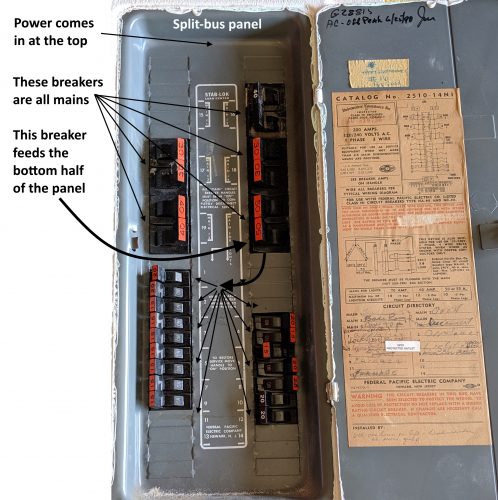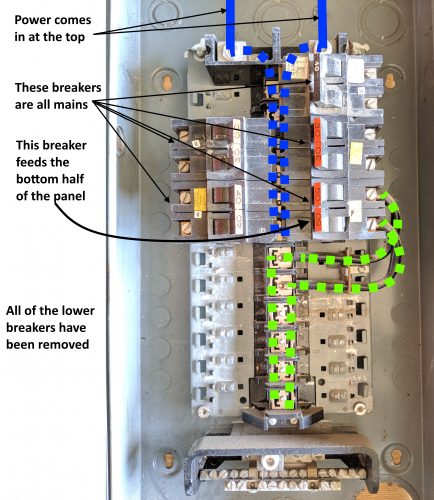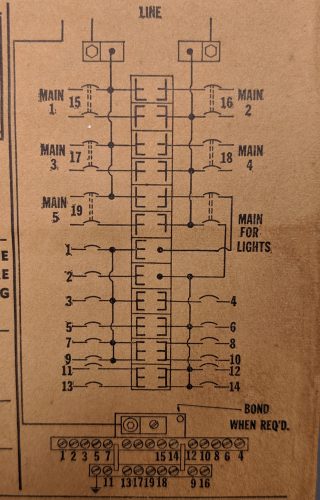Split-bus electrical panels are different from other electrical panels because they don’t have a single circuit breaker to shut off all of the power. These panels usually have several circuit breakers labeled “Main”, and they’re all mains. There can actually be up to six main breakers in these panels. Most of the split-bus panels I’ve inspected have space for up to six mains, but they’re not always used, and some panels have less.
Split-bus panel explained
Here’s a marked-up photo of a split bus panel with most of the circuit breakers removed. Power comes in at the top, and all of the circuit breakers at the top are mains. To turn off power to the entire home, you’d need to turn off all of these breakers.
Here’s that same panel with the cover removed, as well as all of the lower breakers.
The circuit breaker at the bottom right supplies power to the bottom half of the panel, which contains all of the 120-volt lighting and appliance circuits. Once you turn off that breaker, you’ve turned off most of the power to the house. But not all of it.
This diagram inside the panel illustrates the same thing.
Sizing a service with a split-bus panel
For an electric service with a split-bus panel, you generally go with the service amperage listed in the panel. If it says 200 amps, it’s probably a 200 amp service. I know, I know, this isn’t what all of the breakers in the “mains” section add up to, but that doesn’t matter. Just like it doesn’t matter what all of the circuit breakers in your home add up to.
The history of split bus panels
According to my favorite electrical book, Electrical Inspection of Existing Dwellings, split bus panels were allowed starting in 1965. The ‘main’ breakers were only supposed to be 240-volt two-pole breakers. You weren’t supposed to have individual 120-volt circuit breakers supplying power to 15 and 20 amp lighting and appliance branch circuits… for the most part. There was an exception to that rule in 1978.
This means that if you see a single-pole circuit breaker used in the ‘mains’ section of a split bus panel, it’s not necessarily wrong. As a home inspector, this certainly isn’t something that would make my report, because I’d have a hard time explaining to my client how this could be unsafe.
Beginning in 1981, new installations of split bus panels were no longer allowed, but existing installations were allowed to remain in place.
Conclusion
There’s nothing unsafe about a split-bus panel. It’s easier to have a single circuit breaker to disconnect power, but this doesn’t make existing installations unsafe. Said in my most soothing therapist’s voice: “They just need to be understood.”





bill f
August 27, 2019, 7:02 am
What was the intended purpose of the “extra” main breakers?
Large power items like A/C and Electric water heaters or additional panels?
Reuben Saltzman
August 28, 2019, 6:57 am
Correct, large power items like AC, water heater, oven, etc.